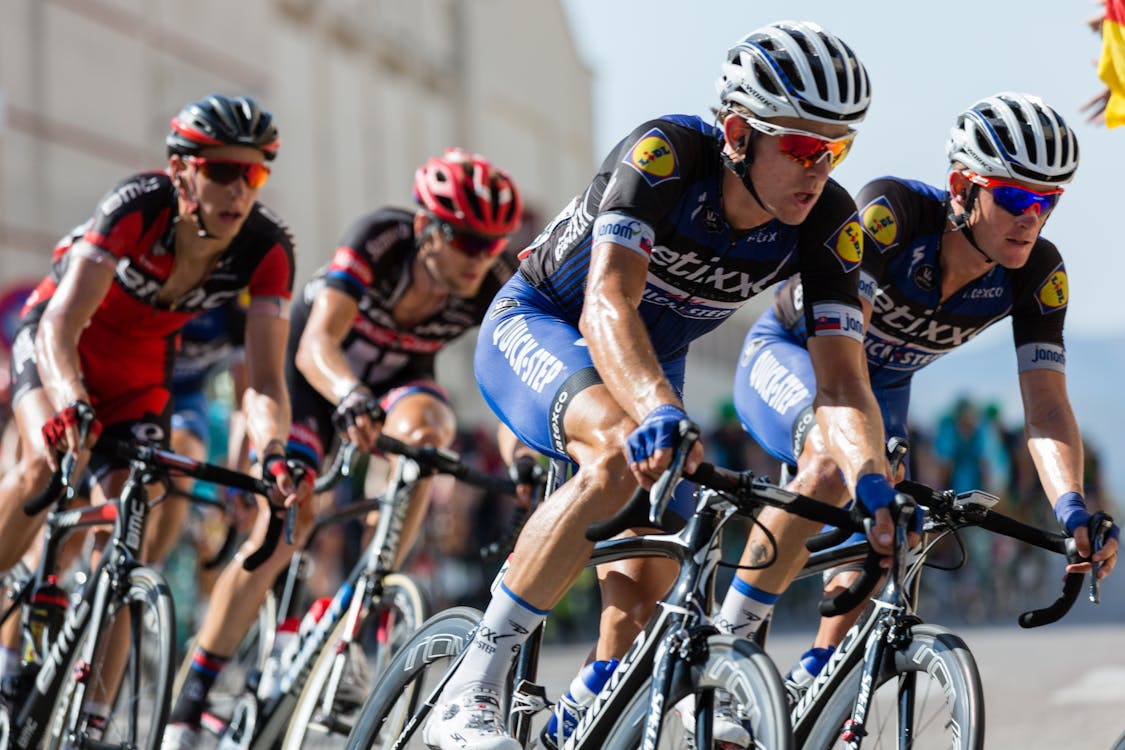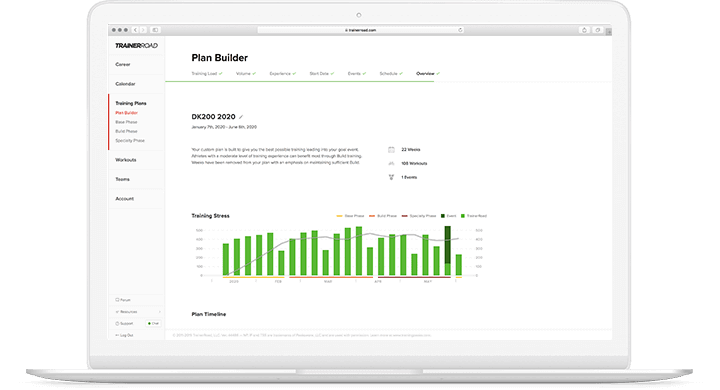Cycling is all about freedom. You can ride as far and as fast as your legs can take you. But after some time many of us might start wondering – what’s next? Here’s when different options come into play. And that includes implementing a cycling training plan.
Part of Cycling Advice
The feeling of speed is like no other, and before you know it, you’re hooked. But how do you get faster? It’s a question that’s been asked since the invention of bicycles.
Scientists, cyclists, and consumers alike have played with weight, gearing, material, and shape to increase the speed of their bicycle – but above all, the biggest determining factor is your legs.
The stronger and fitter you are, the faster you will go. And thus comes the invention of training plans.
Contents
How Does a Cycling Training Plan Work
Training plans are structured calendars of bike rides and workouts with a specific goal in mind.
For most, the goal is simple: get faster.
But for others, a training schedule is meant to make them fitter, help them lose weight, or improve their endurance.
Many cyclists use a training program from a coach, website, book, forum, and more. The options are endless, but it is easy to get started. Here are the different kinds of training plans that you will find, and what is included in each of them.
What They Include
Beginner Cycling Training Plan
A beginner training plan includes weekly goals pertaining to volume, intensity, and mileage.
The phrases used are general rather than specific such as, “Ride 100 miles in total this week,” and often rely on RPE (rating of perceived exertion) and tempo rather on precise metrics.
Related: How to Start Cycling (40+)
You can find a beginner training plan on the internet, and they are usually available for free. You’ll find some workouts including sprints and hill repetitions. They won’t be catered to you or any specific metrics as we’ll see in the higher-level training programs.
A beginner training program is often hand-written or uploaded straight into your calendar. The instructions are short and to the point, and you won’t get any feedback from training software or a personal coach.
These plans are structured in multi-week blocks typically around 6-12 weeks long. This will keep you motivated throughout the entire block, without feeling like an overwhelming commitment of 6 months or a year.
6-12 weeks is also the minimum amount of time that you’ll need to make significant and noticeable gains. As well as develop good training habits and start nailing the workouts.
Once you’ve tackled your first few beginner training blocks and are looking for more, you’re ready for an intermediate workout plan.
Related: Cycling Tips For Beginners
Intermediate Cycling Training Plan

An intermediate training plan includes metrics such as functional threshold power (ftp) in watts, heart rate, and cadence RPM zones to help you track and monitor your training. B over the short-term and the long term.
These cycling plans are a bit more advanced than others. They can even be found on websites and training software such as TrainingPeaks, Today’s Plan, and TrainerRoad. An intermediate training plan is for experienced riders who want to take their aerobic fitness to the next level.
When you first start riding, there are many gains to be made by riding more and adding structure to your training.
But once you’ve been training for more than a year or two, you will make fitness gains quicker and more efficiently with an intermediate workout plan.
These training programs use specific training metrics such as max power and heart rate to structure your workouts, set goals, and track progress. You’ll need a few extra devices – like a power meter and heart rate monitor – to track these metrics. They are definitely worth it.
With these devices, you’ll be able to objectively measure your training load. They help you plan your workouts with much more specificity than before. Training with power and or heart rate is a big milestone for any cyclist. It will change the way that you approach your training.
Much of your plan’s structure, workouts, and overall look will be the same as a beginner plan. It will become much more specific using power and heart rate training zones.
These are used to push you into your lactate threshold realm, or endurance realm on a long ride, or hold you back during a recovery ride. It is truly the most effective and efficient way to get the most out of your training.
Advanced Training Plans
An advanced training plan includes all of the above and more, such as advanced training metrics such as fitness, fatigue, form, and more.
Depending on the training program and or the training software it uses, you might get different terms than these. But you should remember that the intention is the same.
These advanced training metrics are meant to tell you when you are in shape, when you are tired, and when you are in peak form. A good cycling plan and software can calculate these metrics based on your current and previous training load, which will help you plan your peak for certain events or races.
You can find advanced structured training workouts on many of the same websites listed above such as TrainingPeaks and Today’s Plan.
These plans will be designed for serious cyclists and those with big events or racing goals. An advanced training program can help you structure your training many months out from your goal event. It will help you reach peak form just at the right time.
Other cycling programs will help you improve your cycling fitness and structure your weekly training. Some also include nutrition and hydration guidelines and ensure you get enough carbohydrates.
An advanced training plan will do much, much more including a daily evaluation of your current form and fitness, as well as estimating what your form and fitness will be in the future.
These plans also allow you to plan your workouts and weekly agenda in advance and then tell you where your form will be at any specified time.
Cycling Training Plans for Racers

A racer’s workout plan will be either an intermediate or advanced program, with the main addition being a careful inclusion of races.
Instead of weekly workouts on repeat, a racer’s training program will be more carefully structured. From week to week as they train, rest, and peak for certain races.
As opposed to a consistent weekly training schedule, a racer’s plan is a bit more complicated. You will never know exactly how much a race will take out of you.
While experienced racers have learned what their bodies can handle and how much time they need to recover, many bike racers hire coaches to help with their training plan.
Cycling coaches are more than just cycling plan writers. The best ones know and understand their athletes, both physically and mentally.
They recognize that every athlete is different and that just because this training approach worked for one athlete, doesn’t necessarily mean it will work for another.
Good mentors communicate with their athletes, and feedback goes both ways. If something isn’t working for the athlete, their cycling trainer will make adjustments, and help them find what works best.
Coaches help write their athlete’s training timetable, but it is as much an open conversation as it is a set of instructions.
Cycling mentors are best at understanding an athlete’s training needs and goals because they come from an outsider’s perspective. They can help remind the athlete what is objectively best for them.
Most elite racers have trainers in addition to an advanced cycling program, and those two are often tied together.
A cycling instructor can help their athlete undergo fitness testing, evaluate their power and heart rate zones as a professional, and then prescribe specific training sessions in line with the athlete’s goals.
Benefits of Training Plans
From reading above, you’ve probably guessed that structured training workouts are the best and most efficient way to get faster, and without burning out.
Here are a few key ways in which a quality training program helps us improve as cyclists.
Improving

With a specific cycling training plan, you will be able to track your progress and improvements on both a short-term and long-term basis. Each week, you’ll see where you stack up during your high-intensity workouts.
Whether you have a power meter, heart rate monitor, or nothing at all, you’ll be able to tell if you are improving.
Using training websites and software such as TrainingPeaks, you can also evaluate your fitness, monitor your progress, and track your personal records over many years and seasons of training.
This is incredibly helpful for building a long-term plan and setting goals.
Monitoring Fitness
 When it comes to monitoring fitness, a cycling training program is the best place to start because you will be able to simultaneously measure your progress and evaluate your fitness.
When it comes to monitoring fitness, a cycling training program is the best place to start because you will be able to simultaneously measure your progress and evaluate your fitness.
Software such as TrainingPeaks will calculate specific numbers referring to your overall fitness, as well as telling you how tired you are.
Training metrics such as volume, duration, frequency, and intensity are great tools for measuring your fitness and spotting overall trends. You should have both low-volume and high-volume weeks to keep things stimulating while having enough rest.
By tracking your training and planning it ahead of time, you can monitor your current fitness while also planning for the next week or month.
This is the key to maintaining balance in your training, improving your overall fitness while also taking some well-earned rest.
Basic Knowledge
The above is getting into the depths of cycling training principles, but let’s go back and cover some basics.
In any cycling training plan, you will be writing down your intended ride volume and structure for each day of the week.
Most athletes plan at least 7 days in advance, while others will plan weeks or months ahead of time.
With each ride, you’ll want to plan out the overall duration and intensity based on the goal of the ride. For example, a high-intensity interval session could be “1 hour with 4×8 minute threshold intervals,” while a recovery ride could be “30 minute easy spin.”
Most training programs include 2-3 high-intensity interval (HIIT) sessions per week, with 1 day off the bike, and the rest of the days being easy muscular endurance rides.
This is the scientifically-proven structure that helps most cyclists increase their overall fitness while also earning adequate rest on a rest day.
Know your goals and know your structure, and you will begin to understand your training development.
Avoiding Overtraining
One of the most important parts of a good cycling training program is avoiding overtraining.
Built into the structure of a proper cycling training plan is adequate rest – this allows your mind and body to recover from the hard efforts and high training load, and to come back stronger.
Related: Best Foam Rollers
Avoiding overtraining is tricky, and many riders get it wrong. But when you stick to a training schedule – and especially if you have a great cycling coach – you will avoid overtraining.
Overtraining is not just a word of warning – the effects can be serious and damaging, and sometimes take months, or even years to repair.
Take overtraining seriously, rest when you need to, and you’ll be happier and stronger on the bike.
How to Choose a Training Plan

There are so many ways to find a structured training schedule that the options can seem overwhelming. In the old days, you would take to your friends, fellow cyclists, or walk into the local bike shop.
Nowadays, while those options are still available, there are now thousands of plans, trainers, and coaches to choose from on the internet. So where do you begin?
When looking for a training program, it’s as simple as a Google search. Type in your goals and rider type (e.g. beginner century training plan) and you’ll see thousands of options pop up.
TrainingPeaks is the #1 resource for cycling training on the internet, as they are not just a single website, but rather a coaching and training platform.
That means that instructors from around the world (including myself: ZNehr Coaching) can upload their plans to TrainingPeaks which can then be purchased by anyone with a TrainingPeaks account.
The process is simple and only takes a few clicks.
You can also sort by a number of filters including price, duration, and experience level.
TrainingPeaks gives you the most options with the most specificity, and will even put a face to the name so that you can contact the coach directly in case you have any questions.
You’ll find training programs on specialized websites everywhere, including FasCat Coaching, CTS, TrainerRoad, and more.
These are individual coaching companies that write a number of plans for interested cyclists. There are not as many plans on these websites, so it is less likely that you will find the perfect fit.
However, these companies have their own unique brand that may appeal to different riders.
A Personalized Training Plan
When it comes to personalization, you can contact these coaching companies directly to get a custom plan and work with a cycling trainer one-on-one. Cycling coaching is a unique endeavor because most of the time it is done remotely.
Most cycling instructors write and adjust their athletes’ training programs from hundreds (or thousands) of miles away, speak with them on the phone, and check in with them on a daily or weekly basis.
So when you’re looking for a cycling trainer and a custom training approach, there are almost as many options as there are generic choices.
Local contacts are best for an in-person approach, as these people will know your region and they will be able to meet with you in person.
Remote trainers are all over the internet – unsurprisingly – and you can again find them with a Google search.
Like many other companies, I put my training plans and info on my website (zachnehr.com), and this is how people usually get their first glance at my services.
After browsing through a few options, you can contact most coaches directly through their websites. Some will charge a consultation fee while others (like myself) do not.
What you want to look for is price, flexibility, contact time, and personalization.
Benefits of a Personalized Training Plan
 A personal or remote trainer can provide you with so much more feedback than a cookie-cutter structured training schedule.
A personal or remote trainer can provide you with so much more feedback than a cookie-cutter structured training schedule.
Sure, the workouts that you buy might be great quality and highly-effective workouts, but if anything goes wrong or your schedule changes, then it’s up to you to fix it.
A personal coach will help you through these adjustments – both minor and major – while also giving you the opportunity to ask questions.
I find that many of my clients enjoy the personal conversation and specific feedback as much as they enjoy the structured workouts and custom training plan that I provide. And those are the benefits of a personal cycling instructor.
Personal cycling experts can also talk with you all throughout the year, including the off-season, base season, and racing season.
An instructor can help you evaluate your current fitness, examine your cycling goals, and help develop an effective and sustainable plan to help you reach them.
FAQ
How many hours a week should I cycle for training?
Weekly training volume is completely individual, and so there are some elite-level cyclists that train 10 hours/week, while others train up to 30 hours/week.
Your weekly training volume should be determined by your current fitness and long-term goals.
Beginner cyclists should aim for 5 hours/week, while advanced cyclists can aim for 8-12 hours/week.
Elite cyclists often train more than 12 hours/week, with some amateur riders completing as much as 20-30 hours/week.
How do you structure a cycling training program?
A cycling training program consists of daily workouts, recovery rides, and a week-to-week structure that helps you build your fitness and improve your overall performance.
Your workouts should consist of high-intensity intervals tailored to your goal event, while your long-term planning should balance both fitness-building training and rest.
A good rule of thumb is to structure each week with 2 high-intensity interval sessions, 3-4 easy endurance rides, and 1-2 days off.
What is a good cycling training plan?
A good cycling workout plan is well thought-out, easy to explain, and well-balanced. The workouts should be easy to understand, as should the weekly training. The plan should be designed specifically for your goals and fit into your lifestyle.
Does Strava have training plans for cyclists?
Yes, Strava has a number of cycling (and running) plans for riders of all abilities and goals. These training programs are “Powered by CTS (Carmichael Training Systems) which is an American coaching company.
Is cycling everyday too much?
Not at all. Your body can and will adapt to your training load, including cycling every day. To increase your chances of better recovery and overall performance, we recommend taking one day off of cycling every 1-2 weeks.
Any other questions?
Contact me at [email protected]. I’ve run ZNehr Coaching for a number of years now, helping athletes of all ages and abilities achieve their goals in cycling, racing, ultra-endurance cycling, and triathlon.
I write about cycling and coaching on a regular basis on Cyclingnews, Velonews, and TrainingPeaks. You can find more information about me at zachnehr.com






